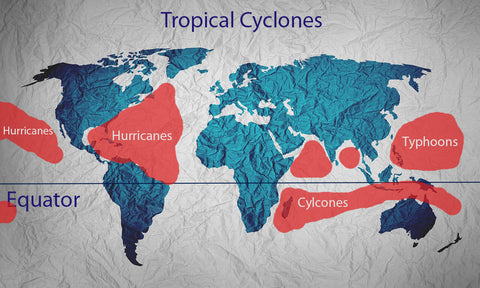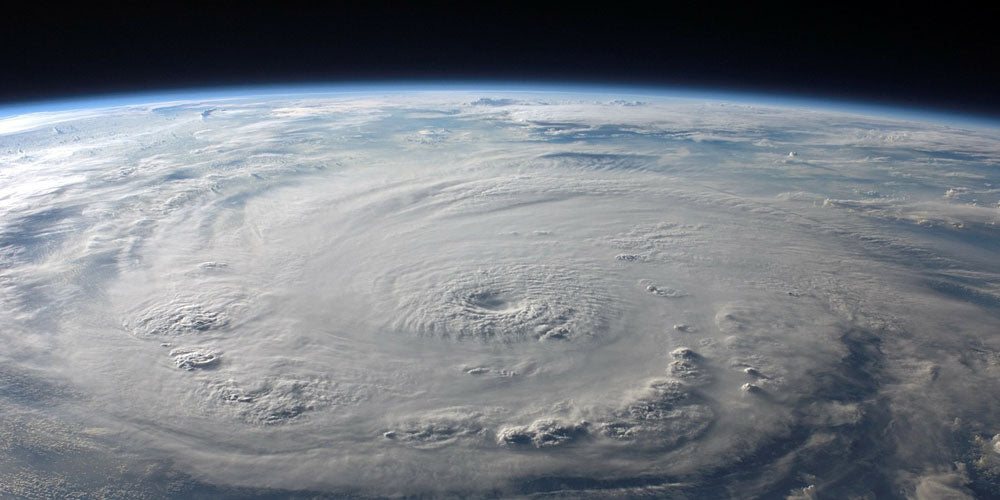What is a hurricane?
A hurricane is a massive swirling storm that is created in the oceans of warmer climates. Hurricanes, typhoons, and cyclones are all types of tropical storms, named after where they occur, with no difference other than location. Hurricanes form in the Atlantic of the west coast of Africa, while typhoons most frequently form off the east coast of Asia. However, the generic scientific term for these storms is a tropical cyclone.
You don't have to be a meteorologist to know that hurricanes can cause a lot of damage, but what causes hurricanes? You can say hurricanes are actually like giant engines that get their energy from moist air in oceans in tropical climates.
How do hurricanes form?
To understand entirely how hurricanes form we need to take it step by step; from what allows the hurricane to develop, to what keeps them going, and the classifications of hurricanes.
We would also recommend taking a look at how wind is formed to improve your understanding.
- For a hurricane to form, it needs to meet a set of conditions, e.g., specific latitudes - 5–20 degrees north or south of the equator. It also requires a lot of heat, and ocean surface temperatures of at least 26°C.
- If the above conditions are met, the ocean water begins to evaporate and condense, creating towering clouds and heavy rainfall.
- An area of low pressure is formed due to the rising warm air, leaving less air near the surface of the water. This area of low pressure then 'sucks' the air in, in an attempt to replace the missing air.
- Air from the surrounding area that has higher pressure, floods into the area of low pressure, replacing the missing air with 'new' air, which also becomes warm and moist, causing it to rise and create a continuous up-flow of vapour that rises, cools and condenses into clouds. This is also what causes the hurricane to spin. However, all storms that form north of the equator spin counter clockwise, and storms that form south of the equator spin clockwise. This is due to the Coriolis effect.
- The above steps repeat as the storm grows, rotating faster and faster, creating the eye in the centre of the storm. The eye is the calm, clear, low-pressure centre of the storm and 'pulls' high-pressure air in through the top of the storm - further 'feeding' the storm.
- Tropical storms, although they can cause damage, can't travel far inland. This is because once the storm begins to move away from the water, its energy source starts to dwindle.
Storm classifications
- Tropical depression - Winds of 20-34 knots (38 mph or less); accompanied by an area of low pressure and thunderstorms that produce a circular wind flow.
- Tropical storm - Winds of 35-64 knots (39-73 mph); tropical depressions upgrade into a tropical storm when the cyclonic circulation becomes more organised. This is where the naming of storms begins to take place.
- Tropical cyclone - Winds of 64-82 knots (74-95 mph); this is where a tropical storm upgrades into, in this instance, a hurricane, with the eye around 5 to 30 miles wide. This is where they are given categories - category 1 being less intense and category 5 being very severe.
- Category 1 - Wind speeds of 64-82 knots (74-95mph); produces dangerous winds, but with minimal damage to occur at landfall.
- Category 2 - Wind speeds of 83-95 knots (96-110 mph); produces hazardous winds and causes moderate damage to occur at landfall.
- Category 3 - Winds speeds of 96-113 knots (111-129 mph); produces extensive damage to occur at landfall.
- Category 4 - Wind speeds of 114-135 knots (130-156 mph); produces extreme damage to occur at landfall.
- Category 5 - Wind speeds above 135 knots (157 mph); produces catastrophic damage to occur at landfall.
Where and when do tropical cyclones occur?
The distinction between different kinds of tropical cyclones depends entirely on where they are formed. What's interesting, it is possible for more than one cyclone to occur in the same region at the same time.
Hurricanes are formed over waters where temperatures exceed 26°C. They occur over the Atlantic and North-East Pacific Oceans, and the areas that are most exposed to them are the southern parts of the United States and the African coast. Particularly extreme hurricanes are most common along the east coast of the United States, in the Caribbean, less frequently along the west coasts of the United States and Mexico. Cyclones that occur in the Atlantic region and affect the United States regions constitute around 15% of total global tropical cyclone activity.
Typhoons are tropical cyclones that occur in eastern and south-eastern Asia; they are formed over the Western Pacific between 180 and 100 meridians. The word typhoon derives from Chinese and its literal meaning is "wind from Taiwan". Typhoons occur mostly in summer and autumn. The winds of a typhoon can reach very high speeds, bringing extremely heavy rainfall. Typhoons often cause a significant damage due to their great power. Occurring in in the southern hemisphere, winds in a typhoon move clockwise.
Locations of tropical cyclones

- Hurricanes - Atlantic and North-East Pacific Oceans - Occur between June and November
- Typhoon/Super typhoon - North-West Pacific Ocean - Occur all year round, but has a primary season between July and November
- Severe tropical cyclone - South-West Pacific and South-East Indian Ocean - Occur late October/early November to May
- Severe cyclonic storm - North Indian Ocean - Occur between April and December
- Tropical cyclone - South-West Indian Ocean - Occur between Late October/early November to May
Due to the climate change, tropical cyclones have also started occurring in regions that have been generally considered out of the range of such disasters up until recent times, e.g., Hurricane Vince in 2005, which struck southwestern Spain; and Subtropical Storm Alpha in 2020 - northern Portugal.
Sources
- Tropical cyclones – metoffice.gov.uk https://www.metoffice.gov.uk/weather/tropicalcyclone/facts
- Hurricane center – baynews9.com http://www.baynews9.com/content/news/baynews9/weather/hurricane-center/wind-speeds.html
- Hurricanes – nasa.gov https://spaceplace.nasa.gov/hurricanes/en/
- Hurricanes – bbc.co.uk http://www.bbc.co.uk/schools/gcsebitesize/geography/natural_hazards/hurricanes_rev1.shtml
- Hurricanes – nasa.gov https://www.nasa.gov/audience/forstudents/k-4/stories/nasa-knows/what-are-hurricanes-k4.html
- Hurricanes – scikinks.gov https://scijinks.gov/hurricane/
- Weather – accuweather.com https://www.accuweather.com/en/weather-news/whats-the-difference-between-a/34388

